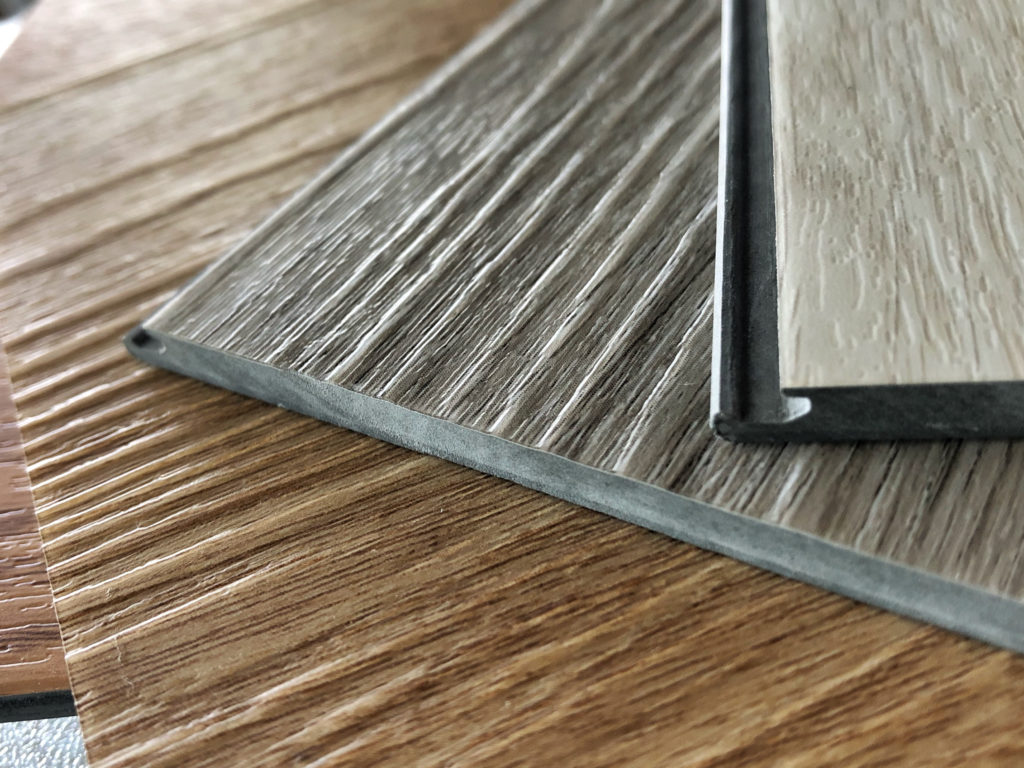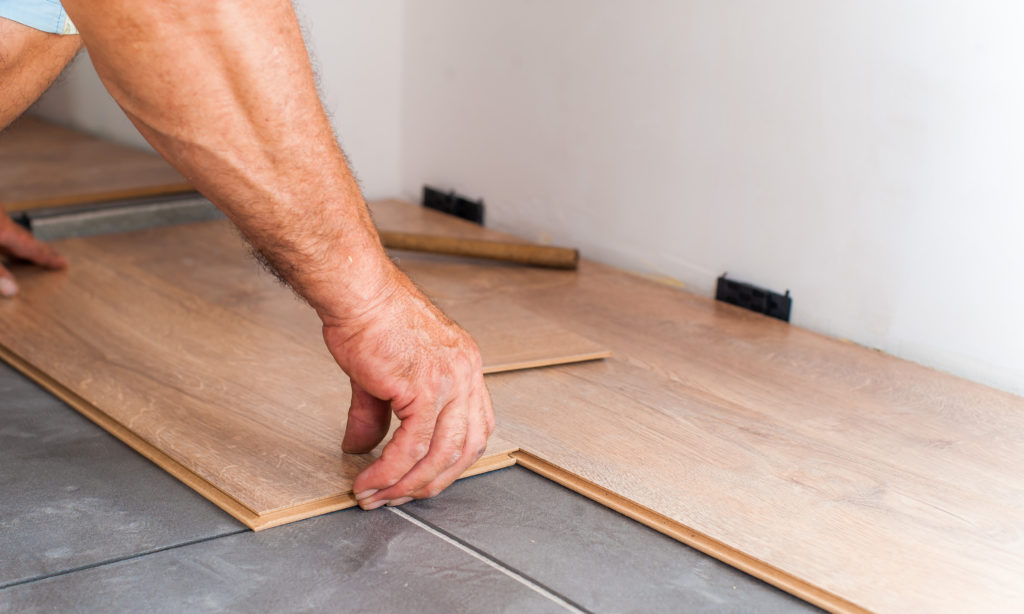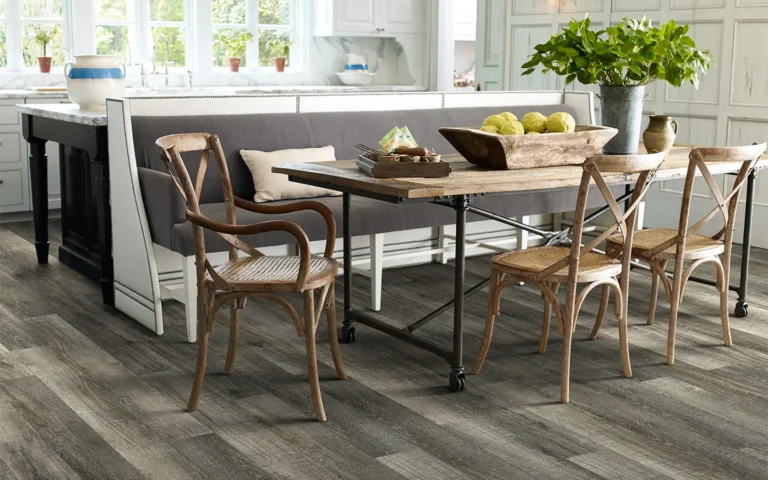This post may contain references or links to products from one or more partners of our parent company and/or subsidiaries of our parent company. For more information, visit this page.
Updated June 29, 2020
Looking into the advantages and disadvantages of floating floors? We hear you. The pros and cons of floating floors… well, let’s just say they’re a common topic in the flooring world.
Look, if you’re anything like us, you know that remodeling can be equal parts exciting and stressful. Sure, you may be ready to do away with that decades-old peeling vinyl in your kitchen or the unloved burnt orange shag carpet in your living room (finally). And sure, the end result of redoing your floors—whether it’s a beautifully stained hardwood or sleek tile—is always nice to think about.
But all of the steps in between can be overwhelming. What types of flooring are in my budget? Which types will give me the most options for color, style, and refinishing? Which types can I install myself?
Whatever material you decide on, there’s a good chance that these days, it’ll mean purchasing floating floors. As you may or may not know, a “floating floor” actually refers to an installation method, rather than the floor itself. A floating floor doesn’t need to be secured to a subfloor (and “what is subflooring“, you ask?) and can often be installed over existing surfaces.
Because of this, it’s become one of the most popular ways for flooring to be installed, and many of the best types of vinyl flooring around (as well as laminate and even some wood flooring types) can be purchased in a floating setup.
But as we all know, there pros and cons of floating floors. And that, friend, is why we’re here today. Use this guide to explore the advantages and disadvantages of floating floors, and to determine whether this is the right method for you.
What are floating floors?
Like we said, the term “floating floors” actually refers to a type of installation rather than the flooring material itself.
Think about it this way—there are three ways that you can install new floors: glue-down, nail-down, or floating. The first two types, unsurprisingly, are more permanent options than floating floors.
How do floating floors work?
If you’re getting a floating floor, it usually means you’re getting click-together flooring. Also known as click-lock or snap-together flooring, these flooring planks have an intricate tongue-and-groove system that allows them to seamlessly snap into place.

They’re simply locked together end-over-end and are laid over the subfloor. And they don’t need to be glued or nailed down because the strength and pressure of their connection keeps them in place. Sounds pretty easy, right? That’s because it is!
Best Brands of 2024
Disadvantages of floating floors
Let’s start with the negatives. Floating floors can undeniably be gorgeous, but they can come with their own share of cons, too. Before you’re ready to walk out of your local flooring store with your heart set on a new floor, you may want to consider both sides of the floating floor coin.
Floating floors may need to be replaced more frequently
If you picture your floating flooring in layers, it goes something like this: the subfloor, a tiny layer of air, and then the floating floor. Because of that slim layer of space, your home’s daily activities have a higher impact on the floor. Is this a huge disadvantage of floating floors? It can be—but it can also be fixed relatively easily.
For example, in a home office, a heavy chair on wheels may cause a floating floor to show signs of wear more quickly than a glued-down or nailed-down floor—though this highly depends on the type of product you buy and the underlayment you use. Many of the best cork flooring products, for instance, come in floating setups but might not show signs of wear as quickly because they’re so springy.
Plus, that feeling of (literally) walking on air can actually feel great for people with knee, ankle, and back problems. All of that to say, if your home is often a hub of traffic from kids, visitors, and pets, you might want to look into durable flooring options to fit your needs.
Floating floors may amplify sound
That gap between your floating floors and the subfloors may be troublesome when you need your steps to be quiet. In rooms where the floors are glued or nailed down, the connection between floor and subfloor layers reduces the sound from footfalls.
On floating floors, however, the pressure of your steps on that air cushion can amplify your movement. So if you’re thinking of putting floating floors somewhere like a baby nursery or another space that should stay quiet, you may want to invest in a high-quality underlayment. According to Floor Covering News, an appropriate underlayment can almost entirely mitigate sound concerns (often thought of as one of the biggest disadvantages of floating floors).
Alternatively, if you like your home to be more of a hush-hush environment, we recommend checking out some traditional carpet options to explore what’s right for you. If you aren’t sold on carpet, you can always take it for a test drive with easily removable peel-and-stick carpet tiles.
They can’t be refinished as many times (or at all)
Ok, this is actually due to the type of flooring you choose rather than the way it’s installed, but it is something to consider.
See, click-together hardwood floors are usually made of engineered wood, rather than solid wood. Engineered wood is actually composed of two layers—a thick base layer made of plywood or HDF, and a thin “veneer” layer made of natural hardwood on top. Due to the width of the veneer, engineered hardwood can’t be refinished nearly as many times as solid hardwood—and occasionally, not at all. Though with today’s super-durable factory finishes, refinishing is less of an issue.
Do solid hardwood floors come as click-together floating floors? Sometimes! But it’s definitely less common. And since other floors that come in this style—laminate and vinyl for instance—can’t be refinished at all, floating floors are, by default, less able to be refinished.
Humid environments can occasionally pose issues with floating floors
Floating floors can allow a floor to contract and expand with different humidity levels. That can be a big plus if you’re looking into certain types of hardwood or considering the pros and cons of cork flooring.
But, it can also be one of the big disadvantages of floating floors if you live somewhere that experiences extremely high humidity. This is also due to the space between the floor and subfloor. If a lot of moisture accumulates in there, it may contribute to warping, pitting, or mold growth.
These issues can also be mitigated by using an appropriate underlayment, though, so make sure to talk to a local flooring dealer before you buy your floors. They’re the real experts! And if you decide that you do need some waterproof flooring options for the most moisture-prone rooms in your house, make sure to consider the pros and cons of tile vs. laminate.
Advantages of floating floors
Alright, now that you’ve heard all about the disadvantages of floating floors, you’re ready to hear why they can also be a fantastic choice for your home.
They can save you money
There’s great news for remodelers on a budget: floating floors generally cost less to install than their nail- or glue-down counterparts. That’s because they need less expertise to install, they can be installed over existing surfaces, and they can generally be laid down faster (though we’ll talk about that in a second). Plus, they don’t require any material like adhesive or nails.

Also: if you’ve fallen in love with a floor that appears to be offered in a glue- or nail-down version only, chances are there’s a more affordable floating variety available. Find a flooring store in your area to get more specifics!
Floating floors are super DIY-friendly
Yet another way that floating floors can soften the blow to your bank account: you don’t need to hire a professional to install them!
Ok, ok—so we’d still recommend having a professional install your floors. Unless you’re a seasoned DIY-er, trying to install them yourself can be immensely stressful and potentially damaging to the material. But: while some things should always be left to the professionals—like electrical wiring and plumbing—this flooring option offers much more potential for do-it-yourself installation.
They can be much easier to replace
Since floating floors aren’t fastened to the subfloor in any way, they’re able to be repaired and replaced much more easily. Think about it. If something horrid happens and one of your floating planks gets damaged, you can simply pop it out and replace it!
Of course, you do have to take out all the boards between the damaged piece and the wall, but it’s endlessly easier to do than trying to pull up a single nailed- or glued-down plank. In fact, the only floor that’s easier to replace would be certain types of tile, which can be chiseled out piece-by-piece.
And of course, if you decide to replace your floor entirely, floating floors are much easier to take out since they don’t have any adhesives or nails to extract.
Conclusion: the disadvantages of floating floors are minor, but the advantages are major
In the end, only you can decide whether a floating floor is right for your home—but all things being equal, we think the disadvantages of floating floors are relatively minor compared to their upsides. And these days, advances like snap-together tile flooring have made it so even tile can be installed as a floating floor. You love to see it!
Additionally, most disadvantages of floating floors can easily be addressed with minimal effort by choosing the right material and a proper underlayment. For help doing that, use this flooring stores near me search to find a local retailer in your area. They’ll help you through every step of the process! And for more resources on all things flooring, check out:
About The Author

Savannah Howe
February 28, 2020
Savannah is a midwestern writer who dabbles in blogging, poetry, and news. When she's not stuck behind a desk, she can be found hiking, in a coffee shop, or chasing a rambunctious toddler.





